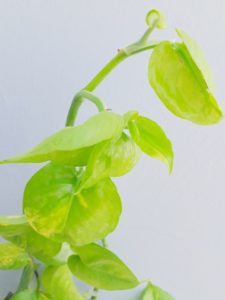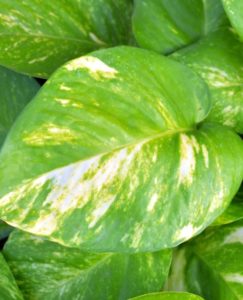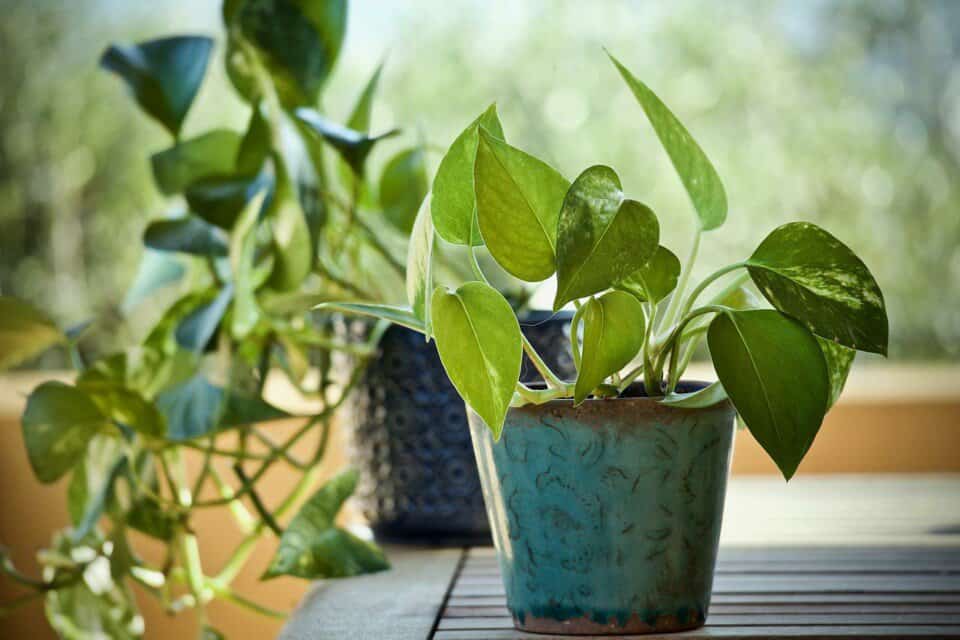Some links in the post are affiliate links and I get a commission from purchases made through some links found in the post.
If you want to know why is my pothos growing small leaves, then you are at the right place. The pothos plant is well-liked for its rich green foliage and how easy it is to care for.
The Pothos creates a stunning display with its dark green, glossy, and sometimes variegated leaves, and mature varieties can grow up to three feet tall. However, the new leaves are sometimes very small compared to the old ones.
Inadequate hydration, a lack of sufficient lighting, and fertilizer rich in nutrients are the three primary factors that lead to the development of smaller leaves on pothos plants.
Pothos can better retain their foliage by addressing these important difficulties and undergoing frequent trimming, which also helps them grow larger healthier leaves.
So, read this article, and you will learn why your pothos has small leaves, how to grow them in bigger sizes, etc.
Why are My Pothos Growing Small Leaves?
Let’s go into more detail to learn about the science underlying the pothos’ ability to adapt to its environment and the reasons why your pothos is growing small leaves more than those of other plants.
Light:
 We all recall learning that light is necessary for plants to produce food in primary school. Photosynthesis is the process responsible for producing plant food, which is necessary for the plant to continue to exist.
We all recall learning that light is necessary for plants to produce food in primary school. Photosynthesis is the process responsible for producing plant food, which is necessary for the plant to continue to exist.
In addition, because chlorophyll is present in the leaves, converting sunlight into food takes place there.
When pothos does not receive enough light, the plant’s trailing stems become thinner and grow in the light source direction. Pothos are frequently used as trailing plants.
Fertilizer:
A nutrient-rich fertilizer should regularly be used in moderate amounts with pothos, just as with any other houseplant.
It is best to use liquid fertilizers and types that have a delayed release if you want to preserve the lush color, waxy texture, and the size and form of its leaves.
Watering Problems:
We all know that light is an essential component for photosynthesis in the leaves of plants, but water is also an essential component of this process.
Even while pothos prefers to be allowed to dry out between waterings, providing it with a good soaking once every week to two weeks will guarantee that the brilliant glossy leaf keeps its sheen.
Temperature:
Pothos plants grow in temperatures ranging from 70 to 90 degrees Fahrenheit. Temperatures outside this range can induce tissue damage and death, or they might inhibit growth and cause leaf shrinkage.
Leaves can become scarce as well as tiny. As a result, ensure your pothos plant is positioned in a warm environment with no chilly draughts and that it is not immediately exposed to excessive heat.
Humidity:
A lack of humidity is another potential cause of leaf shrinkage in pothos plants. Pothos plants thrive in high humidity situations because they are tropical plants.
During the winter months, the air within our houses can get dry. However, lock humidity might promote the growth of tiny leaves.
You can use a humidity tray (a tray with stones partly immersed in water), spritz the plant, or invest in a humidifier to enhance humidity levels surrounding the plant, especially if humidity levels in your home are lower than the recommended 40 percent -60 percent.
Small Container:
A pothos plant will tolerate being pot-bound to a certain extent. If the pot is too small and the rootball is so huge that there is very little potting mix left in the pot, you should move your plant as soon as possible.
Pothos plants that are highly pot confined will produce new growth to survive. However, because no nutrients are available to promote their growth, the new growth will be feeble, and the leaves will be little.
Don’t overfill the pot when repotting. The new pot should only be one or two times larger than the old one.
Will Small Leaves Grow Bigger?
If you are new to growing this plant and have noticed that the leaves are on the smaller side, you may wonder, “Do pothos leaves grow larger after unfurling?” I was curious about the answer to this question when I saw new growth on one of my Pothos plants for the first time.
Will I be stuck with these small leaves for the rest of my life? The good news is that you will not!
Yes! Pothos leaves DO grow in size after unfurling. New leaves are a bright green color that is thin, waxy, and tiny.
However, as they mature, they grow considerably larger and stronger (provided you are caring for the plant properly).
Should You Cut off The Small Pothos Leaves?
 Yes, take off damaged pothos leaves as soon as you find them. It’s not always enough because you don’t want a vine too thin or buried in the ground to grow.
Yes, take off damaged pothos leaves as soon as you find them. It’s not always enough because you don’t want a vine too thin or buried in the ground to grow.
Detecting deterioration and determining its root causes are the first steps in restoring your antique pothos to their former glory. Early discoveries can assist you in bringing your pothos plant back to life.
There are some frequent signs that your pothos plant is injured or dying that you may easily recognize. Yellow leaf is a common issue for pothos growers.
You will not like the tarnished yellowish appearance of your plant. At the same time, leaving yellow leaves on the plant may harm its health.
Droopy Leaves are also quite prevalent if your plant is experiencing difficulties. Proper care might help you restore your plant’s natural appearance.
- Falling Leaves
- The leaves are discolored.
- Bacterial infections or root rot
Brown leaves, white patches on the foliage or tree, or undergrowth could indicate that your pothos plant is sick.
If you see any of the following symbols on your pothos plant, it is best to cut off the afflicted area to treat the plant as soon as possible.
There are some typical causes for developing these signals, and I urge that you seek assistance from any reputable website to discover the underlying causes of these issues.
However, if a bacterial illness causes the damage, it is best to remove the leaves to eliminate the disease, as these can be spread and cause the plant to die.
Removing damaged leaves from pothos plants is best if you don’t want them to turn brown or yellow.
Will the Cutback Leaves Regrow?
Pothos plants cannot recover leaves that have been removed by you or that have fallen off due to disease or damage. But don’t worry, the pothos, like other plants, the pothos will regenerate new leaves.
Pothos plants can grow long, weak stems with no leaves for various causes, which I shall address further below. Occasionally, leaves get infected or damaged.
Why is Pothos Not Growing New Leaves?
There could be various reasons your pothos plant isn’t producing new leaves. Here are some considerations to bear in mind:
A deficiency in light:
When a pothos plant does not receive an adequate amount of light, the stems of the plant will begin to grow toward any light source.
This causes the stems to become extremely long and fragile, which makes it difficult for the plant to produce leaves.
Root rot, which is brought on by overwatering:
The pothos plant is sensitive to having too much water poured on it. When left in wet soil for a lengthy period, their roots are more likely to decay quickly.
A deficiency in nutrients:
In addition to a deficiency in nutrients from decaying roots, nutrients in the soil surrounding potted pothos plants can also deplete.
Because of this, it will be challenging for the plant to maintain its growth, let alone produce new leaves. Pothos plants require some fertilization, even though they are not heavy feeders.
Disease:
Pothos plants are susceptible to various leaf diseases and pest infestations, both of which can stunt the plant’s growth, resulting in the loss of leaves and an inability to produce new ones.
Low Temperatures:
The plant and its leaves can develop abnormally if subjected to temperatures lower than the optimal range for pothos, between 65 and 80 degrees Fahrenheit.
How Do You Make Pothos Leaves Bigger?
 Do you desire for the leaves on your pothos plant to be larger? Or why are my Pothos growing small leaves?
Do you desire for the leaves on your pothos plant to be larger? Or why are my Pothos growing small leaves?
Don’t we all of us! You are in luck since there are a few strategies you can employ to stimulate the growth of larger leaves.
Put your plant on a stake. When allowed to climb up a stake or trellis, pothos leaves tend to expand to a bigger size.
When the plant is allowed to cascade downward, the leaves will not grow to be as large. Put a stake or a trellis for houseplants inside the container, and then wrap the vines around it to teach the plant to grow upward.
Give your plant some food:
The pothos plant does not require a great deal of fertilizer. However, if you want your leaves to get as big as possible, you must ensure they have enough food.
Although, it is highly recommended that you use a balanced fertilizer such as Jack’s All-Purpose (this is the fertilizer I put on my pothos, and the plant adores it).
Bringing in more light:
This plant requires a great deal of direct and indirect light to encourage the growth of larger leaves.
If you don’t have a spot in your house that gets enough natural light, you might want to look into purchasing some artificial plant lights to make up the difference.
From what I’ve seen, the most common issue that most people have with pothos is that they don’t give it enough light.
This is most likely the root cause of your stagnant progress that you’ve been experiencing. Aside from that, it’s a really simple plant to cultivate, so you shouldn’t have too many problems with it.
Final Thoughts
Even though they are young, new leaves can have an appearance of maturity and good health. There are several potential explanations why a plant could not produce a leaf of the size you anticipate.
Little leaves can be a symptom of more serious issues, such as a lack of nutrients or stress from heat or water. Smaller leaves indicate a deficiency in one or more aspects of plant nutrition, such as light, water, or fertilizer.
This immaturity of the leaves can also be caused by overwatering and frequent fertilization. So we hope you get to know why your Pothos is growing small leaves.


